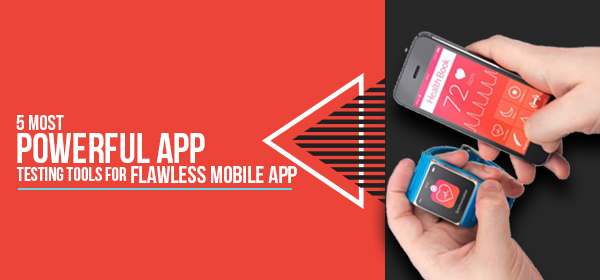Inevitable use of internet and mobile apps has greatly inspired enterprises to perform their business operations via mobile apps. Gartner predicts that the worldwide mobile phone sales is likely to reach 1.93 billion units by 2019, which further increases demands for consumer-focused mobile apps. However, not all apps have potential to please customers. Whether or not your app will be a success depends on how good your app is to customers.
User ratings and downloads are key to app success and reflect the measure of customer experience. That is why it is essential for any digital business to invest in mobile app testing and development. Testing of mobile apps with the right tools can ensure that your app is able to deliver personalized and friction-less user experience.
Let’s explore those 5 powerful app testing tools for flawless mobile app:
1. TestFairy
TestFairy is a free app testing tool and contains impressive features that work exceedingly well for mobile app developers and testers.
Features:
Its most compelling feature is its video recording capability. TestFairy allows developers to record a video when the app is being tested. This helps them see what precisely went wrong during the development process and where the problem lies.
In addition to this, TestFairy also offers:
- Memory logs
- Crash reports
- GPS
With such excellent features, it becomes easy for developers and QA professionals to locate the issue through history of occurrences.
TestFairy is one easy-to-operate, hassle-free tool that also keeps you informed of user behaviour through recorded videos.
2. Open Sauce
Open Sauce is another considerable app testing tool by Sauce Labs designed to focus on open source projects. It offers full testing environment to make sure the app is bug-free and has appreciable performance standard.
Features:
- Users can test the app on 5 parallel virtual machines
- You can test the app across 700+ browsers
- Take screen shots of problem areas and errors
The major advantage you receive from Open Sauce is that you can resort to screen shots to check the errors. It also helps improve development process efficiency and app quality keeping its UI intact.
To start using Open Sauce, you can go to its website and get registered using Google code or Github services and add your project URL with a small project summary.
3. EggPlant
This is a unique test automation tool designed by TestPlant for testing Android and iOS apps.
Features:
- Instead of tapping into apps user interface framework like many traditional tools, EggPlant leverages its intelligent image analysis technology to view the display screen and perform testing tasks.
- It uses SenseTalk, a simple proprietary scripting language, to achieve scripting of the app.
- It offers a reliable integrated debugging environment to identify and address problem points in the app.
Users can use one or more scripts to establish test scenario to test app functionality across multiple OS and devices.
The tool is best suited for organizations that intend to develop and launch one or more complex applications.
4. Appium
Appium is a widely popular open source testing tool used to test mobile apps, responsive mobile web apps, and native as well as hybrid apps.
It is a developer-friendly tool and has cross-platform testing abilities. Testers can depend on the same API to write codes for various test cases across both iOS and Android platforms.
Features:
- Users of Appium tool can test iOS and Android apps using Selenium Webdriver protocol
- It enables you to write testing codes by choosing your favourite framework from the list of options including JavaScript, C#, PHP, Java, Python and Ruby
- To provide even more comfort, Appium liberates users from needing any special SDK while testing native apps
Clients likeYammer, Mozilla, salesforce, Zillow, cloud9 turn to Appium to achieve impeccable app quality.
5. Ranorex
Ranorex is a simple automated testing software that allows QA testers to run tests on mobile and web applications.
Ranorex saves you a good deal of time eliminating the need to modify device aspects before starting the tests across chief operating systems.
Features:
- Users can recognize GUI objects independent of change in their size, colour or shape
- To help you detect bugs inside the app codes more efficiently, Renorex offers seamless integration with third party tools increasing the speed of app deployment
- Another benefit Ranorex offers to its users is that they can reuse the same codes to design multiple test cases across different devices
It serves renowned companies such as Adidas, Canon, Siemens etc.
How to choose the most powerful App testing tool?
Passing your mobile apps through a powerful app testing tool certainly contributes to making sure your app is unquestionably a knocker. Checking the app for its quality, performance, speed and usability helps separate the successful app from the unsuccessful one. Important criteria to remember to choose the best mobile app testing tool are:
- Quick app recognition system
- Developer-friendly environment
- Immense testing efficiency, speed and consistency
- Easy viewing and detection of faults and bugs
- Ability to run same test codes across multiple devices
- Minimal time of installation
- Ability to record and view testing events
- Seamless integration with different other testing environments
Your takeaway:
As any mobile app developer would agree, testing mobile apps is incredibly challenging and requires immense attention, patience and dedication. This is why you need right tools or a trustworthy app testing partner. Also, automating testing efforts can add speed and efficiency, saving you a lot of time in the process. Make sure your testing partner is aware of the latest trends in mobile app testing. We hope this article will help you pick the tool that can yield the best results.



